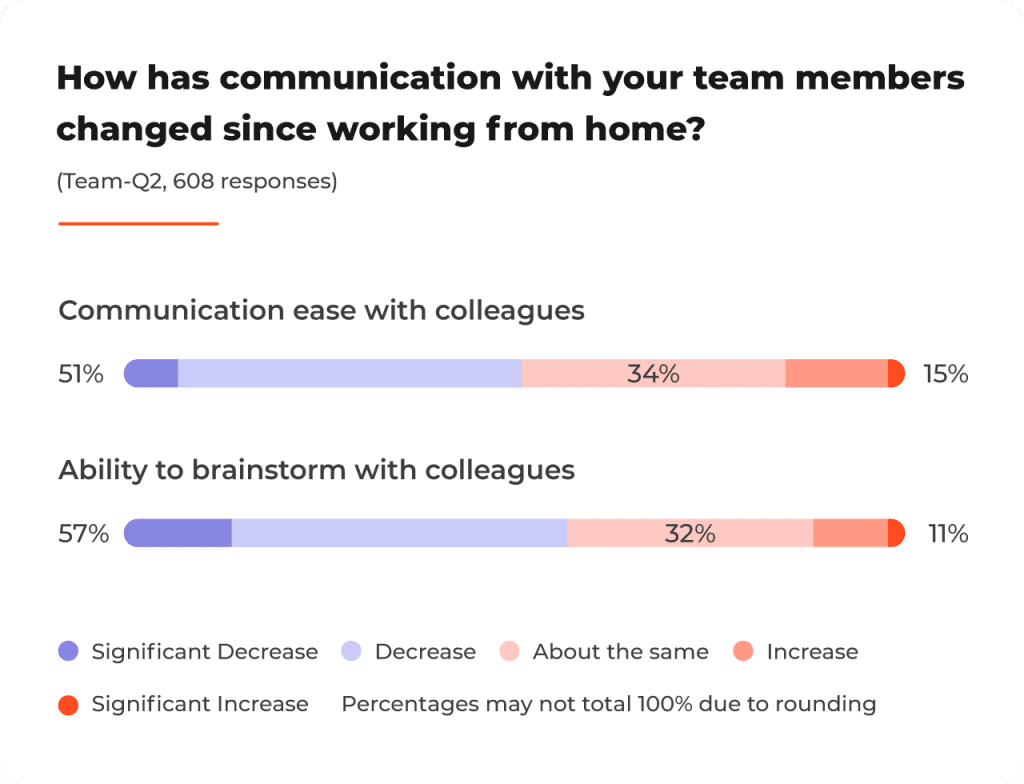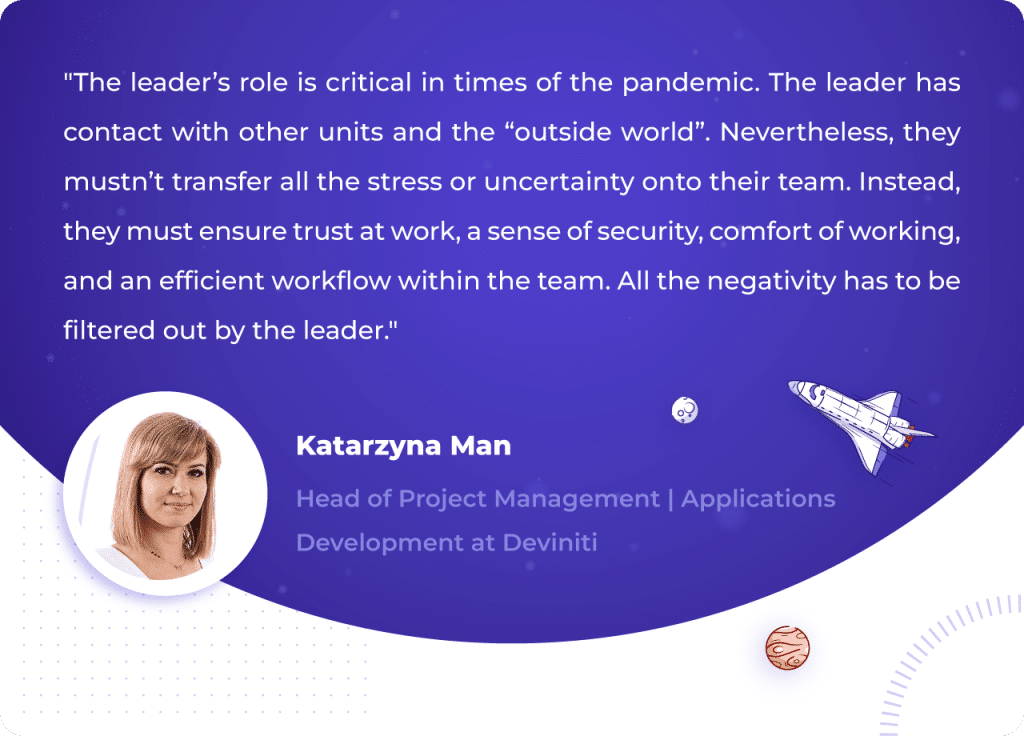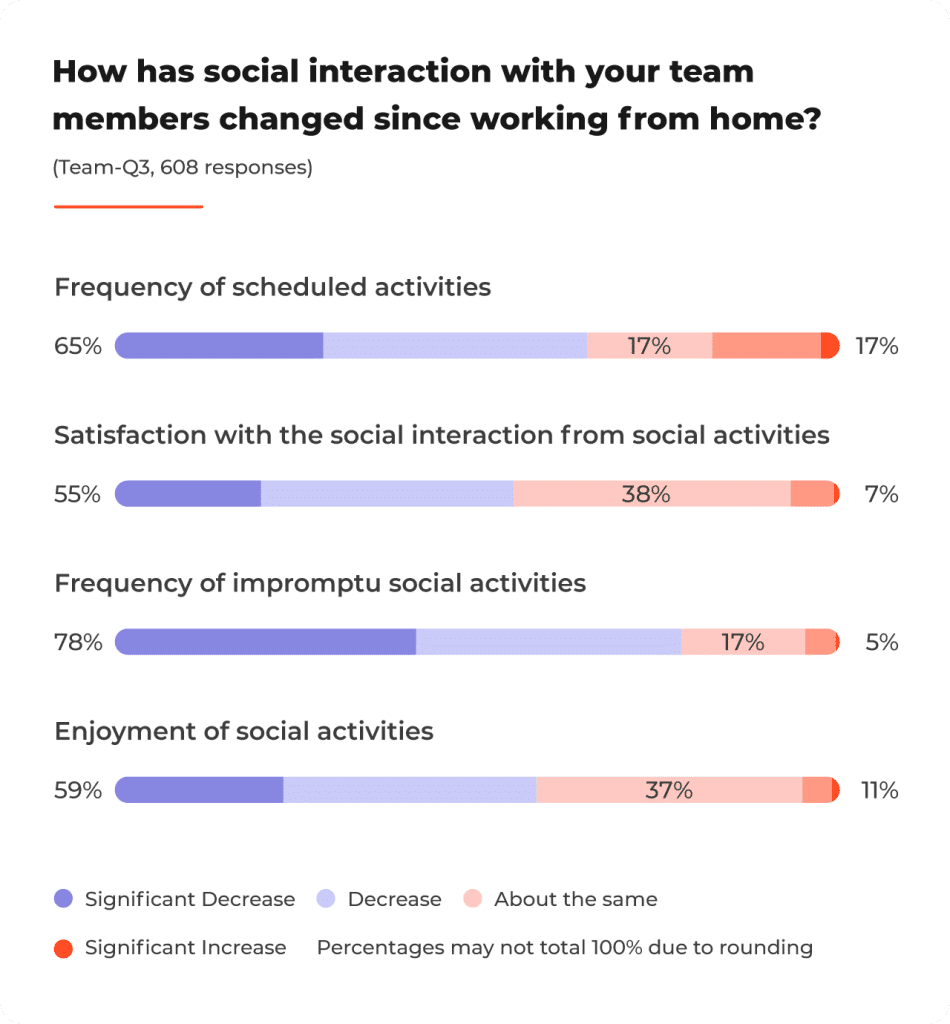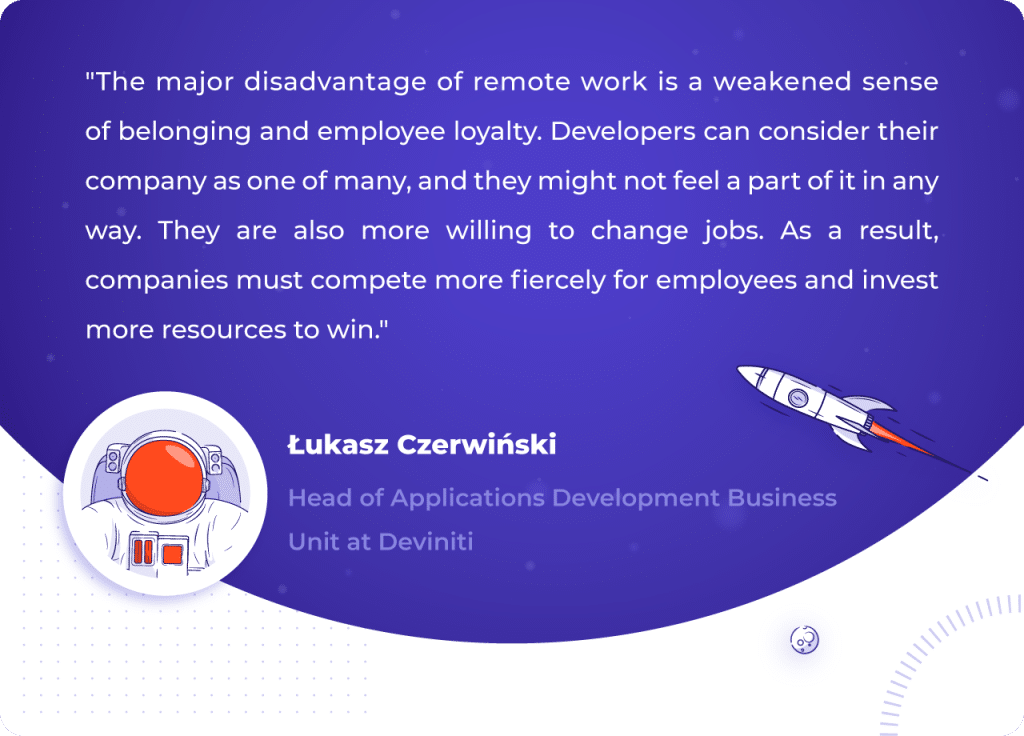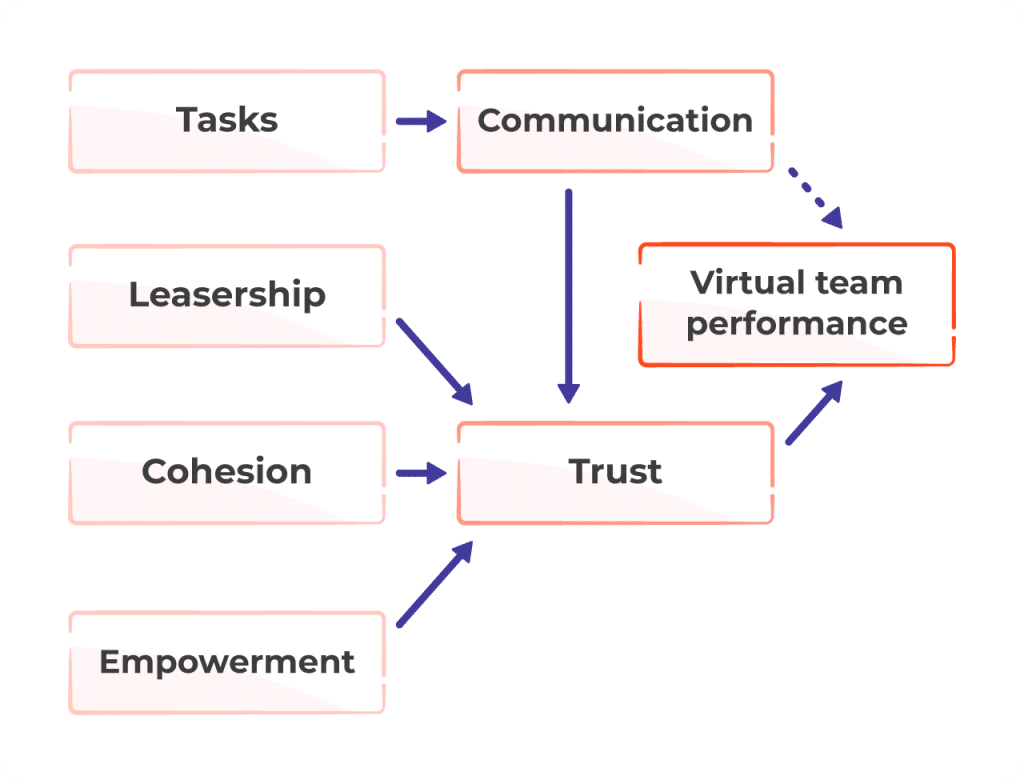7 challenges of a software development team leader during the pandemic

Remote work within software development teams is nothing unusual. However, the pandemic made it a standard. Although we have been practicing remote working for around two years, some areas of software development team management might still pose certain challenges. Luckily, you don’t need to identify them – we provided them all for your convenience, enriched with scientific data and our own experience. Learn about the 7 greatest challenges of software development team leaders during the pandemic.
Most companies were highly affected when the pandemic started. Software houses were most likely one of the least suffering sectors. It stems from the fact that they normally don’t involve direct contact with customers or even between employees. Another crucial aspect is that software houses, similarly to other technology companies, are usually more advanced in terms of digital transformation and remote working tools. Nevertheless, the necessity of establishing a certain remote work policy has brought many challenges in 3 main areas: team communication; efficiency and work organization; team building and employee engagement. Let’s explore these areas and see what challenges await us.
1. The communication challenge
Face-to-face communication is no longer a viable option. Nowadays, people can’t discuss any details of their work “on the go” or have a work-related water-cooler chat. As a result, they have become aware of the major advantage of direct communication. You probably know how easy it was to simply ask someone sitting next to you and get an immediate response in the pre-pandemic era. Such swift exchange of information is much harder during remote working. Table I from a study carried out by Miller et al. shows that ease of communication has been one of the most negatively affected areas. Due to this, you might be missing out on some important job issues. To make things worse, you are most likely already dealing with hundreds of messages fighting for your attention.
Even if you manage to establish some rules of communication, there are still many related issues that need your attention. The case with remote work is that it mostly prevents you from reading any non-verbal signs. As a result, you might miss an important piece of information such as uncertainty, confidence, or displeasure expressed via body language. You can also misinterpret a given text message. Clarification of what people say is also difficult especially after leaving an online meeting. You might receive vague messages on what is happening within the project or specific tasks. You can either wait for making things clear or risk doing your job wrong.
Remember that in times of trouble, passive communication is equally important as its active counterpart. When you don’t have defined procedures, the outcomes can be catastrophic. It often happens that the software development team is divided into subteams. These smaller units can be working on given parts of a project. If they fail to communicate efficiently and don’t have any procedures to follow, their separate tasks simply won’t match. You might experience a situation in which everyone has done their job, but the project is still falling apart. Such results can occur when team members miss essential data to make the project work as a whole.
2. The availability challenge
This problem is deeply related to communication. During remote work, people must mix their professional and private lives. For instance, when they are working from home with a baby on their hands, they might not always be present in the same timeframe as others. They could start or finish at different times, not to mention leaving their “workstation” during the day. Tracking them is difficult even if they provide the details of their schedule. Their messages can simply vanish in the stream of communication. Then, unfortunately, you might not know when to count on whom.
The situation gets worse when you have several people working on the same task. If their schedule is seriously desynchronized, this might prevent them from working coordinately. For instance, developers can’t perform their tasks due to mismatched calendars. This is particularly painful when a part of the project constitutes a roadblock. The software development team leader can have difficulty finding everyone and gathering them to ensure the completion of the project along its sequence and within deadlines. This, in turn, may lead to late delivery or missing parts.
Since we started discussing gatherings, we can’t avoid the topic of meetings. Changing availability is burdensome when we consider meetings – both internal and external. You might have trouble calling everyone in for a team meeting. The situation is more demanding with important video calls with your customers or hired contractors. You can prepare the best plan or schedule. Nevertheless, if your team members are scattered across different places, the probability of something bad happening is much higher.
3. The efficiency challenge
You have probably experienced very high efficiency fluctuations during the pandemic onset. Sometimes, it skyrocketed due to people’s increased sense of duty. In other situations, it plummeted because of team members getting used to new working conditions. Later, it probably stabilized and came back to the pre-pandemic conditions. This is because people started considering their home office jobs as normal working conditions. Many surveys show that employees observe the benefits of remote working such as being more efficient in comparison to office work. Table III from the study by Miller et al. can only confirm that. Nevertheless, they often have their working day more stretched in time. Smite et al. claim in their study that “[i]f developers put more time into achieving the same result, this means that their productivity has decreased.” That is why software development team leaders still face the challenge of how to be productive working remotely.
The case is that lower remote work productivity immediately impacts the entire project. Moreover, mistakes made in the process of completing a project quickly bring disastrous results. Providing support and feedback is essential here. But that is not an easy task when you think about the aforesaid communication challenges. Software development team leaders must keep their eyes open and constantly monitor the ongoing process. Employee supervision is also more complex outside office work. After all, you cannot see what people are doing. And nobody likes to be constantly bothered with messages. Garro-Abarca et al. point out in their study that “[t]oo many controls throughout the work process make the virtual collaborator feel watched and that he is being evaluated negatively.” So, finding the balance between keeping an eye on things and stalking your team members is a modern leader’s dilemma.
Since we already tackled progress tracking, this matter goes both ways. Firstly, you need to track your team members. Those who deal with simple and independent tasks can get more employee autonomy. Whereas people working on complicated and interrelated activities require more employee supervision. Otherwise, their efforts might move in the wrong direction. Secondly, the employees need to track their own working time. This might not be so difficult in terms of developers due to the nature of their work. They can easily follow their work within a work hour tracker. But, for instance, project managers might not always be up to date with their own daily tasks. PM responsibilities heavily rely on contacting others, and such activities are difficult to follow even with the use of the best app to track work hours.
4. The planning challenge
Short-term planning often isn’t greatly affected by remote working. Long-term planning is another story. Establishing long-term goals, KPIs, or even conducting workshops cannot be carried out so easily during remote work. It’s almost as if these activities were meant for office meetings. No matter what efforts you take or what remote working tools you use for communication and organization. Dealing with tasks requiring collective focus or a broader perspective is a real challenge without face-to-face communication. Table I from the abovementioned study clearly presents that brainstorming sessions have significantly suffered during remote work.
The case may not go smoothly with individual planning as well. We must bear in mind that the difference between the planned time of executing a task and the actual time devoted to it directly impacts the costs of a project, and thus, its profitability. The developers might not always correctly assess the time they need for a given task. If they manage to finish it early, there is no worry (apart from reevaluating the required time slots for future reference). However, if the developers go overboard with their schedule, the entire project might suffer. The software development team leader can also impose specific deadlines, but these might not always work for every developer. That is why the leader must communicate with developers in this matter. But, as we already know, communication is obstructed. So, in the end, planning takes up much more effort than it used to.
Another problem comes from the outside world. The shifts in the market may have introduced some changes in the ways how business is done. For example, many software houses can experience dealing with a larger number of smaller projects. This phenomenon stems from small and medium companies speeding up their digital transformation and requiring small projects to be completed. Another reason is larger companies that mostly rely on their own resources while outsourcing smaller projects or dividing larger projects into parts to distribute costs, and follow the execution process to see the results. The market change provokes the need to reorganize the work of software development teams. The developers might find it hard to arrange their schedules. They also might need some reassurance on why the tasks have been planned in such a manner. It is the team leader’s role (and struggle) in terms of efficient work organization.
5. The leadership challenge
When remote work came into play, the role of a leader also changed. Leaders no longer have immediate access to their employees. As we mentioned before, they can’t closely monitor the work of team members to provide assistance if necessary. Another problem is that leaders can’t deal with any discrepancies on the spot. To make things more difficult, leaders must figure out how to reduce the pandemic impact on employees. Some might even say that executing the responsibilities of a leader might prove particularly challenging during remote work. And they are not entirely wrong.
The case of remote work is that nowadays advanced technical skills are simply not enough. Equally valuable abilities include soft skills such as cooperativeness, clear communication, conflict resolution skills as well as problem-solving in terms of managing relationships. That is why the first goal of all software development team leaders during the pandemic is to learn new skills. Leaders must be far more attentive, understanding, and supportive than they have ever been. Delegating responsibilities doesn’t work to such an extent as employee supervision options are limited. Now leaders have to work coordinately, giving advice and talking things through. And not all leaders are ready for such an attitude.
The second goal of a leader is maintaining team cooperativeness. This is not so easy as people are scattered around different places. In this case, the leader must exhibit certain personality traits rather than specific skills. Many people consider the idea that even if an introvert can be a good leader during office work, it takes more of an extrovert to deal with remote work team management. It doesn’t automatically mean that introverts are destined to fail. Both kinds of people must deal with their team’s sense of purpose. They also need to tend to their team members’ professional development needs. However, all these tasks are time-consuming, and it is a real pain to organize them correctly during the software development team leader’s workday.
6. The work comfort challenge
The offices can have the best chill rooms, but these won’t help during remote work. People working from home need to feel that their work isn’t affecting their health or private lives. So, the new work comfort challenge is a mixture of leadership roles and a new approach to trust at work and employee autonomy. Not all companies appreciate the idea of employee trust and autonomy. We can see this through the increasing interest in employee monitoring tools. Paradoxically, lack of trust hinders the success of remote work and the digital transformation. Global Workplace Analytics bluntly summarizes: “One of the biggest holdbacks of remote work is trust—managers simply don’t trust their people to work untethered. They’re used to managing by counting butts-in-seats, rather than by results. That’s not managing, that’s babysitting. What’s more, seeing the back of someone’s head tells a manager nothing about whether that person is actually working.”
As we mentioned in the previous point, the leader must tend to team members’ professional needs. But the same applies to their normal social needs. We are human beings, and we must socialize with others. With no more options of hallway talks, coffee break chats or water-cooler banters, we might become alienated in our common work environment. This can become a detrimental psychological impact of COVID-19. Table II above from the study by Miller et al. shows a significant decrease in overall employee social activities. The software development team leader’s role is to bring the team together and make them have regular interaction just like in pre-pandemic times. This might be difficult during video calls due to talking over others, misunderstandings, or the general distance. What is more, the leader must be very sensitive to employee morale to balance between getting work done and staying satisfied.
Another complication pertains to people’s private lives. The leader must grant their team members a reasonable amount of trust to make them efficient without disrupting their lives. There are various ideas to make this happen. For example, introducing more flexible working time or assessing results instead of calculating working hours. In the first case, the leader should be mindful of the working time arrangement to avoid the aforesaid schedule desynchronization between people. In the second case, the leader must know how much time a specific task will take to generate desired results. Neither strategy is perfect, that’s why establishing work comfort can be challenging.
7. The integrity challenge
When we stopped going to offices, we often lost the feeling of belonging to our company. People who we used to meet turned into faces on screens. Our celebrations of achievements became just ticks on our checklist. When we aren’t very attached to a company, it’s much easier to change jobs. Especially since you don’t have to physically go to a job interview these days. Taking a break from work to participate in a video will suffice to get a new position. Even if the conditions related to salary and benefits are similar, people might still be looking for something more. And companies often start realizing the importance of employee loyalty when the staff turnover rate is already too high. So, can you ensure employee loyalty in these troubled times?
Firstly, remember from the previous point that we are people, and we need social interaction. Our relationships don’t have to and shouldn’t end only with work. It’s more than advisable to occasionally organize a team outing. Of course, this is easier said than done with COVID-19 restrictions still in place. Another idea is to conduct a virtual outing, but can this one be as pleasant as a real one? It’s hard to say and sometimes even harder to get an opinion from your team members.
Secondly, if you want to decrease the staff turnover rate, you should help your team members develop a sense of belonging. That is why you can involve them in various CSR or brand-related activities aimed at building employee loyalty toward the company. The problem is that not all companies take part in such events. What is more, employees used to remote working might not be so willing to participate in any “extracurricular” tasks apart from their usual work. You can always offer them a reward for participation. But can your company spare anything for such rewards?
Challenge accepted?
As you can see, remote work poses various challenges on many levels. Even if the developers’ work could be done remotely, being permanently stuck at home has its consequences. Communication requires extra effort, efficiency calls for flexibility, and team integrity is nearly impossible to maintain. The most difficult part is that all the elements above must go together and the failure of one can immediately start a chain reaction affecting others.
The graph above from a study by Garro-Abarca et al. shows the direct relationships between all the elements. To get the efficiency (virtual team performance) right, you need proper communication and trust at work. Trust, in turn, comes from leadership, team integrity (cohesion), and employee autonomy (empowerment). As a software development team leader, you need to maintain a delicate balance between the work to be done and integrity and trust at work. Only then they can ensure the appropriate execution of tasks and achieve the desired results.
We have considered all the major challenges facing software development team leaders during the pandemic. Most of these challenges relate to managing people and keeping your team together. Nevertheless, making your team feel good and appreciated despite constant remote work is critical to conducting company processes. Make sure to regularly check up on your team to guarantee that they stay happy with their work and can perfectly manage all their tasks.
Learn more about the challenges
Another story related to software development team leadership is encouraging project time tracking. Learn more on this topic: discover the benefits of time tracking and ways to make it happen in your team!
